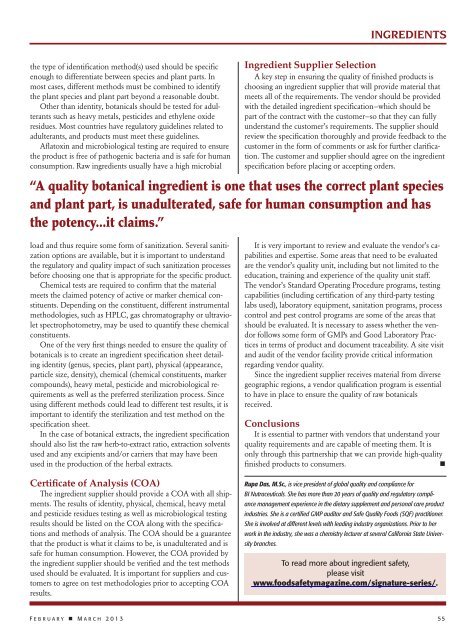Food Safety Magazine, February/March 2013
Food Safety Magazine, February/March 2013
Food Safety Magazine, February/March 2013
You also want an ePaper? Increase the reach of your titles
YUMPU automatically turns print PDFs into web optimized ePapers that Google loves.
INGREDIENTSthe type of identification method(s) used should be specificenough to differentiate between species and plant parts. Inmost cases, different methods must be combined to identifythe plant species and plant part beyond a reasonable doubt.Other than identity, botanicals should be tested for adulterantssuch as heavy metals, pesticides and ethylene oxideresidues. Most countries have regulatory guidelines related toadulterants, and products must meet these guidelines.Aflatoxin and microbiological testing are required to ensurethe product is free of pathogenic bacteria and is safe for humanconsumption. Raw ingredients usually have a high microbialIngredient Supplier SelectionA key step in ensuring the quality of finished products ischoosing an ingredient supplier that will provide material thatmeets all of the requirements. The vendor should be providedwith the detailed ingredient specification—which should bepart of the contract with the customer—so that they can fullyunderstand the customer’s requirements. The supplier shouldreview the specification thoroughly and provide feedback to thecustomer in the form of comments or ask for further clarification.The customer and supplier should agree on the ingredientspecification before placing or accepting orders.“A quality botanical ingredient is one that uses the correct plant speciesand plant part, is unadulterated, safe for human consumption and hasthe potency...it claims.”load and thus require some form of sanitization. Several sanitizationoptions are available, but it is important to understandthe regulatory and quality impact of such sanitization processesbefore choosing one that is appropriate for the specific product.Chemical tests are required to confirm that the materialmeets the claimed potency of active or marker chemical constituents.Depending on the constituent, different instrumentalmethodologies, such as HPLC, gas chromatography or ultravioletspectrophotometry, may be used to quantify these chemicalconstituents.One of the very first things needed to ensure the quality ofbotanicals is to create an ingredient specification sheet detailingidentity (genus, species, plant part), physical (appearance,particle size, density), chemical (chemical constituents, markercompounds), heavy metal, pesticide and microbiological requirementsas well as the preferred sterilization process. Sinceusing different methods could lead to different test results, it isimportant to identify the sterilization and test method on thespecification sheet.In the case of botanical extracts, the ingredient specificationshould also list the raw herb-to-extract ratio, extraction solventsused and any excipients and/or carriers that may have beenused in the production of the herbal extracts.Certificate of Analysis (COA)The ingredient supplier should provide a COA with all shipments.The results of identity, physical, chemical, heavy metaland pesticide residues testing as well as microbiological testingresults should be listed on the COA along with the specificationsand methods of analysis. The COA should be a guaranteethat the product is what it claims to be, is unadulterated and issafe for human consumption. However, the COA provided bythe ingredient supplier should be verified and the test methodsused should be evaluated. It is important for suppliers and customersto agree on test methodologies prior to accepting COAresults.It is very important to review and evaluate the vendor’s capabilitiesand expertise. Some areas that need to be evaluatedare the vendor’s quality unit, including but not limited to theeducation, training and experience of the quality unit staff.The vendor’s Standard Operating Procedure programs, testingcapabilities (including certification of any third-party testinglabs used), laboratory equipment, sanitation programs, processcontrol and pest control programs are some of the areas thatshould be evaluated. It is necessary to assess whether the vendorfollows some form of GMPs and Good Laboratory Practicesin terms of product and document traceability. A site visitand audit of the vendor facility provide critical informationregarding vendor quality.Since the ingredient supplier receives material from diversegeographic regions, a vendor qualification program is essentialto have in place to ensure the quality of raw botanicalsreceived.ConclusionsIt is essential to partner with vendors that understand yourquality requirements and are capable of meeting them. It isonly through this partnership that we can provide high-qualityfinished products to consumers.•Rupa Das, M.Sc., is vice president of global quality and compliance forBI Nutraceuticals. She has more than 20 years of quality and regulatory compliancemanagement experience in the dietary supplement and personal care productindustries. She is a certified GMP auditor and Safe Quality <strong>Food</strong>s (SQF) practitioner.She is involved at different levels with leading industry organizations. Prior to herwork in the industry, she was a chemistry lecturer at several California State Universitybranches.To read more about ingredient safety,please visitwww.foodsafetymagazine.com/signature-series/.F e b r u a r y • M a r c h 2 0 1 3 55






![Otomatik indirilmez ise tıklayınız [Download]](https://img.yumpu.com/44170525/1/190x190/otomatik-indirilmez-ise-taklayanaz-download.jpg?quality=85)









